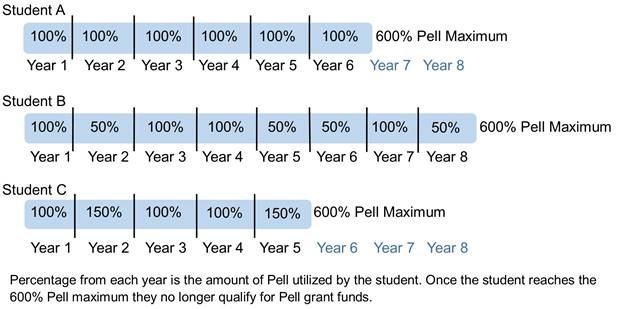Explore Grants
Check your eligibility and apply for grants to pay for college. Find below available grants:
Federal Grant
Pell Grant
Eligibility for a Federal Pell Grant is determined by information provided on a student’s current FAFSA submission. Pell Grant funds do not need to be repaid, however, failure to complete a course may result in a reduction of Pell Grant funding for the semester. The student may be responsible for repaying unearned Pell Grant funds.
The amount of Pell Grant awarded is determine on the student’s Expected Family Contribution (EFC) which is calculated with the FAFSA submittal. Award amounts may be subject to change based on the individual student’s financial need, costs to attend school, enrollment status, and Satisfactory Academic Progress.
Only courses that are applicable to the student’s graduations requirements for their active degree program will be calculated towards enrollment status for Pell Grant eligibility.
Pell Grant Facts:
- The Pell Lifetime Eligibility Usage (LEU) for all undergraduate students is 600%
- The maximum amount of Pell that a student can use in one semester is 50%.
- The maximum amount of Pell that a student can use in one year is 150%.
- The Pell amount is prorated to less than 50% if a student is taking less than 12 credits, for example: 37.5% for 9-11 credits, 25% for 6-8 credits, or 12.5% for 1-5 credits.
- If a student used their full 100% of Pell (by enrolling full-time in fall AND spring) then they are required to enroll in at least six credit hours to receive additional Pell.
- If a student did not use their full 100% of Pell (by enrolling less than full-time in fall OR spring) then they still have remaining eligibility from their original 100% of Pell, and the student can still receive Pell funds in the summer if they are enrolled less-than half-time.
- Any amount of Pell that is not used in one year is forfeited, however unused Pell does not count against the student’s total 600% eligibility.
Each student has a 600% Pell Lifetime Eligibility Usage (LEU) limit. This means that students can use up to 100% of their Pell grant eligibility each year for up to 6 years, or twelve semesters at full-time (if they qualify for the Pell grant based on their FAFSA). If a student does not use the full amount of Pell that they qualify for within the 6 years, they can receive a Pell grant in additional years, until they reach the 600% total lifetime eligibility.
The US Department of Education Appropriations Act, 2017 allows a student to receive Federal Pell Grant funds for up to 150% of the student’s Pell Grant Scheduled Award for an award year, or Year-Round Pell. This provision is effective beginning with the 2017–2018 award year. Students who take full-time course loads receive 50% of their Pell grant in the fall and 50% of their Pell grant in the spring, and are eligible to use up to an additional 50% of their Pell grant in the summer semester, for a total of up to 150%. Below are examples of Pell grant percentages used each year, and how that affects a student’s total 600% Pell LEU. Keep in mind, these are only examples; a Pell grant award will vary depending on enrollment status for each semester during an award year.
Examples:
Federal Supplemental Educational Opportunity Grant
The US Department of Education approves additional grant funds annually to be awarded to students with the highest financial aid unmet need. In addition to the approved Federal funding, Northern Wyoming Community College District (NWCCD) contributes a twenty five percent match. The total Supplemental Educational Opportunity Grant (SEOG) is awarded to students based on the following criteria until all funding is spent. SEOG awards vary annually and per enrollment.
- Expected Family Contribution (EFC) is zero, as determined by the FAFSA
- Be enrolled in a Title IV degree seeking program (associates and/or certificate)
- Students have to be Pell Grant eligible, as determined by the US Department of Education
- Priority will be given to earlier FAFSA submissions
- Award based on enrollment for the semester; full-time, three-quarter-time, half-time or less-than-half-time
- Award is subject to change if an eligible student’s enrollment status changes prior to the Financial Aid census date (freeze date)
Children of Fallen Heroes Scholarship Program
The Consolidated Appropriations Act, 2018 (also know as the fiscal year 2018 omnibus spending bill) that was signed into law on March 23, 2018 created a new scholarship program–Children of Fallen Heroes Scholarship (CFHS). Under the CFHS, a Pell-eligible student whose parent or guardian died in the line of duty while performing as a public safety officer is eligible to receive a maximum Pell Grant for the award year for which the determination of eligibility is made. To qualify for this scholarship, a student must:
- Be Pell-eligible and have a Pell-eligible expected family contribution (EFC) for the award year; and
- Be less than 24 years of age or enrolled at an institution of higher education at the time of his or her parent’s or guardian’s death.
In subsequent award years, the student continues to be eligible for the scholarship, as long as the student has a Pell-eligible EFC and continues to be an eligible student. Instead of a separate scholarship program, the CFHS is awarded as a Federal Pell Grant.
All Title IV aid awarded to such eligible students must be based on an EFC of zero without regard to the student’s calculated EFC. Thus, the student is eligible for the maximum Pell Grant for his or her enrollment status and cost of attendance (COA). In addition, the student’s eligibility for Direct Loans and for campus-based program aid must be based on an EFC of zero.
For purposes of the Children of Fallen Heroes Scholarship, a public safety officer is:
- As defined in section 1204 of title I of the Omnibus Crime Control and Safe Streets Act of 1968 (42 U.S.C. 3796b):
- an individual serving a public agency in an official capacity, with or without compensation, as a law enforcement officer, as a firefighter, or as a chaplain
- an employee of the Federal Emergency Management Agency who is performing official duties of the Agency in an area, if those official duties:
- are related to a major disaster or emergency that has been, or is later, declared to exist with respect to the area under the Robert T. Stafford Disaster Relief and Emergency Assistance Act ( 42 U.S.C. 5121 et seq. ); and
- are determined by the Administrator of the Federal Emergency Management Agency to be hazardous duties;
- an employee of a State, local, or tribal emergency management or civil defense agency who is performing official duties in cooperation with the Federal Emergency Management Agency in an area, if those official duties:
- are related to a major disaster or emergency that has been, or is later, declared to exist with respect to the area under the Robert T. Stafford Disaster Relief and Emergency Assistance Act ( 42 U.S.C. 5121 et seq. ); and
- are determined by the head of the agency to be hazardous duties; or
- a member of a rescue squad or ambulance crew who, as authorized or licensed by law and by the applicable agency or entity, is engaging in rescue activity or in the provision of emergency medical services.
- A fire police officer, defined as an individual who is serving in accordance with State or local law as an officially recognized or designated member of a legally organized public safety agency and provides scene security or directs traffic in response to any fire drill, fire call, or other fire, rescue, or police emergency, or at a planned special event.
NWCCD’s financial aid staff must determine and document, in collaboration with the student, the student’s eligibility for the Children of Fallen Heroes Scholarship Program. Please contact the Financial Aid Office for more information.
Institutional Grants
Employee/Family Grant
The Northern Wyoming Community College District (NWCCD) offers tuition assistance to employees and their eligible family members. The award is applied to each eligible term and is based on several criteria as well as availability of funding. Employees or eligible family members wishing to review additional criteria can access the form in the Financial Aid page of the NWCCD Hub, or stop by the Financial Aid Office. The completed application must be signed by the Human Resources Office and submitted to the Financial Aid Office for processing.
Golden Age Grant
The Golden Age Grant is available to students who are age 60 or above on or before the first day of the semester of enrollment. The grant will cover 50% of tuition charges only (fees are not included). Any remaining balance is the student’s responsibility and must be paid by the payment deadline. 50% of tuition charges will be automatically credited by the financial aid office; no form or application is required to receive the credit. Please call the Financial Aid Office for further details.
Wyoming Works
Wyoming Works provides programs and resources for adult students to learn a skill and secure employment. The program makes available individual grants for students enrolling in approved programs at a Wyoming community college. It also provides a mechanism for colleges to apply for resources in support of the creation of high-demand programs.
For more details, view the Wyoming Works Grant page.


